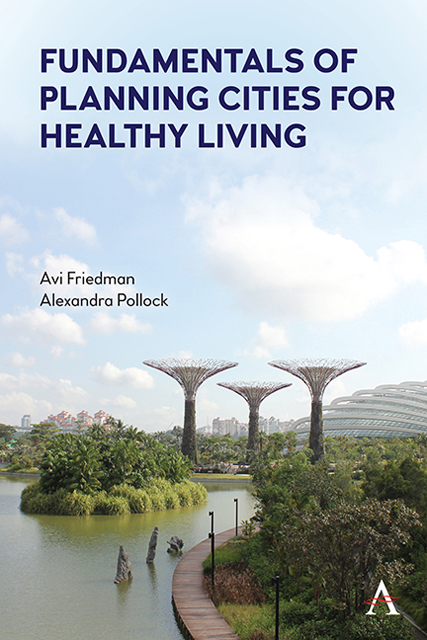Book contents
- Frontmatter
- Contents
- Preface
- Acknowledgments
- Chapter 1 The Broad View
- Chapter 2 Form, Function, and Public Health
- Chapter 3 Planning for Active Mobility
- Chapter 4 Green Open Spaces
- Chapter 5 Active Life in Winter Cities
- Chapter 6 Socializing in Communities
- Chapter 7 Food Production and Distribution
- Chapter 8 Urban Design for Healthy Aging
- Chapter 9 Public and Multi-Unit Residential Buildings and Public Health
- Chapter 10 Healthy Residences
- Chapter 11 Equitable Health Promotion
- Bibliography
- Bibliography for Case Studies
- Illustrations’ Credits
- Index
Chapter 2 - Form, Function, and Public Health
Published online by Cambridge University Press: 10 January 2023
- Frontmatter
- Contents
- Preface
- Acknowledgments
- Chapter 1 The Broad View
- Chapter 2 Form, Function, and Public Health
- Chapter 3 Planning for Active Mobility
- Chapter 4 Green Open Spaces
- Chapter 5 Active Life in Winter Cities
- Chapter 6 Socializing in Communities
- Chapter 7 Food Production and Distribution
- Chapter 8 Urban Design for Healthy Aging
- Chapter 9 Public and Multi-Unit Residential Buildings and Public Health
- Chapter 10 Healthy Residences
- Chapter 11 Equitable Health Promotion
- Bibliography
- Bibliography for Case Studies
- Illustrations’ Credits
- Index
Summary
The built environment has a strong influence on people’s travel behavior. Unable to reach destinations by foot or public transit, people will do it by car. Density and mixed land use are two urban components that can greatly influence travel behavior. Neighborhoods with suitable density and mixed land use can promote physical health, reduce air pollution and facilitate social interaction. This chapter investigates the effect of a place’s urban form on public health. It draws heavily from settings where there are decades of evidence to support the negative health implications of car-oriented urban planning. The State of Washington’s Grow Community, recognized as one of the most sustainable developments in the United States, is presented as a case study to outline the principles discussed.
2.1 Urban Form: What Makes Cities Beautiful and Healthy?
The distinctive sense of place that defines the world’s well-loved cities is a result of deliberate urban design decisions. Tourists and residents alike love Paris for its memorable architecture and its iconic boulevard culture. Ask travelers what they enjoy about New York, London, or Montreal and they will likely reference the diverse sights and sounds, the interesting, distinctive visual character, and both manmade and natural attractions. Although those without a background in urban planning may not know what they are referencing, a large part of what people love about these cities is their form, specifically their mixed land use and higher density.
Urban form refers to a city’s physical characteristics, including natural features, architectural, and planning aspects. Ewing and Cervero’s “5Ds” of the built environment (density, diversity, design, distance to transit, and destination access) are a useful tool for categorizing cities’ urban forms and identifying how features determine travel behavior (Ewing and Cervero 2010). Certain spatial configurations result in neighborhoods that are walkable, beautiful, and diverse, while others give way to monotonous, cardominated landscapes (Dempsey et al. 2009). Deliberate planning resulted in a pleasant walk along Chicago’s Riverwalk, on the banks of the Seine in Paris, or on Manhattan’s Riverside Drive. While a river can be beautiful on its own, features like historic architecture, long vistas, and a mix of dwellings, shopping, restaurants, and other attractions are what compel people to visit notable destinations.
- Type
- Chapter
- Information
- Fundamentals of Planning Cities for Healthy Living , pp. 13 - 26Publisher: Anthem PressPrint publication year: 2022

